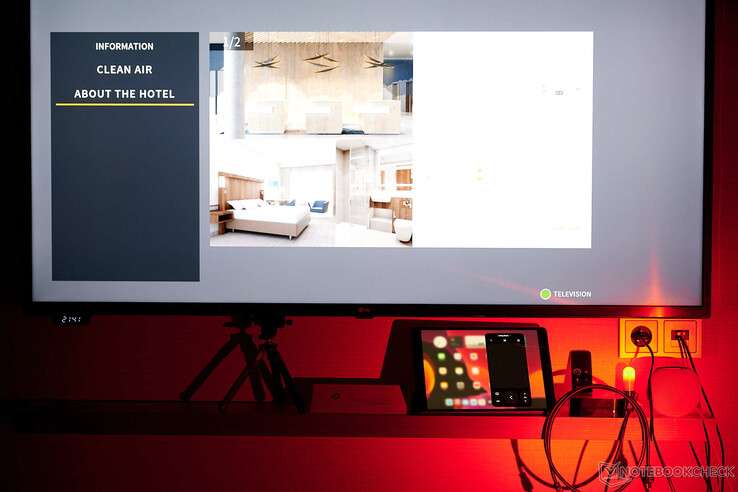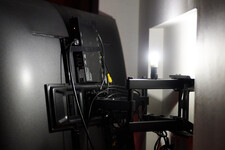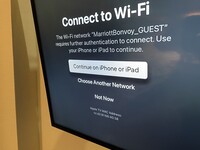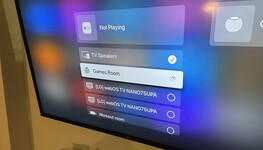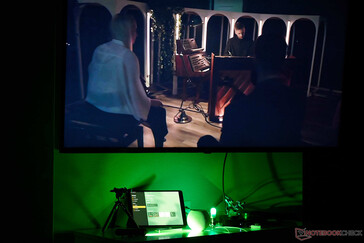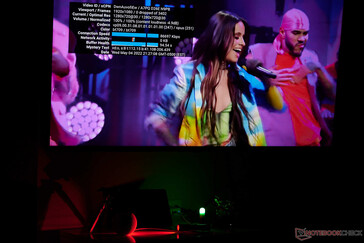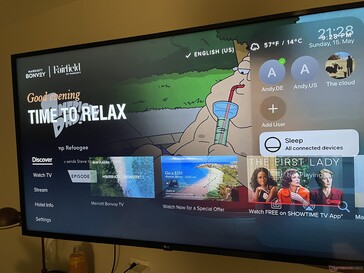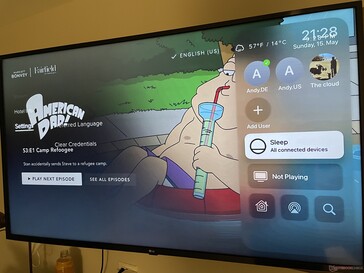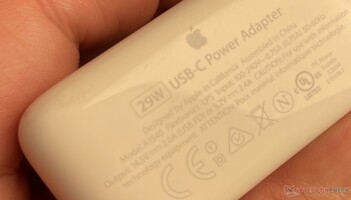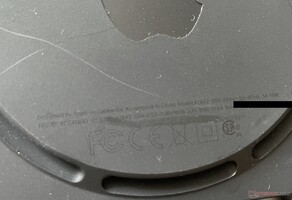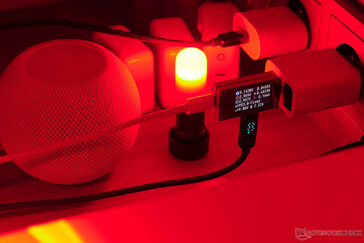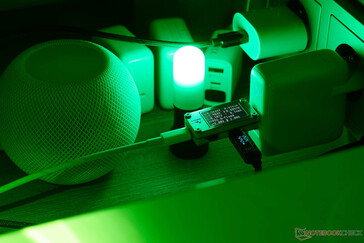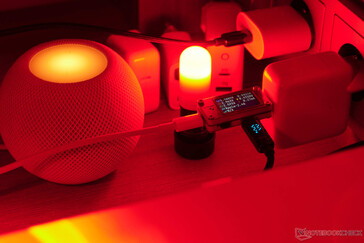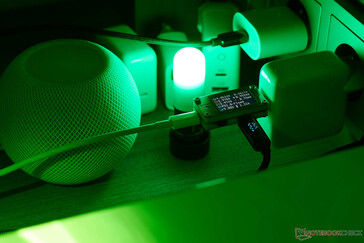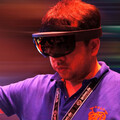Review: The hotel and WLAN hurdles of the Apple TV with HomePod Mini on the road
The Apple TV and the HomePod Mini are basically easy to take along on trips. The media player is small and robust enough to be easily taken in hand luggage. A burlap bag is sufficient to protect the soft surface of the HomePod Mini. It is sturdy anyway, because the speaker rolled off somewhere often enough when we traveled due to its shape.
What the two devices lacked, however, was some sort of travel support for the network functions. Especially those who stay in hotels have to reckon with difficulties. Usually, the WLAN is protected against unauthorized access with so-called captive portals. This is a kind of preliminary portal where access data has to be entered.
In addition, there is so-called client separation, i.e. devices in the same network cannot see each other due to a setting in the WLAN controller. Such settings are more suitable for hotels than using general or even personalized passwords.
A general password bears the risk of being passed on to unauthorized persons, and the latter needs personnel who know their way around in case of a malfunction. This is not a matter of course in hotels. A look at the 802.1X instructions from Apple for radius logins of the Homepod and Apple TV quickly shows that this is not for customers without a technical background.
Anyone familiar with networks will know that these default portals can be set up quickly on many WLAN controllers and represent a good compromise from an administrative point of view. Guests with smartphones, tablets or notebooks can usually get over this hurdle.
For hotel guests with special hardware, however, this is not always the case. This is because a browser is then needed to use the WLAN. Apple's Apple TV doesn't have anything like that. Speakers are certainly not equipped with browsers. However, since version TVOS 15.4 and the HomePod software 15.4, it is possible. The prerequisite is a smartphone or tablet from Apple. Much like when setting up your devices for the first time, all you need to do is follow a simple procedure via your iPhone's Web browser. This is quick and straight forward and easy to do.
Client separation, a measure designed to prevent different people using the same Wi-Fi network from accessing each other's data, might prove to be a restriction. However, this should not really have any effect on the outcomes of our little experiment, and the devices are expected to work just fine - and so they would, in a perfect world.
However, it was anything but easy to implement. We tested with a Apple TV 4K (A1842) with the latest TVOS 15.4.1 and a HomePod Mini (also 15.4.1).
Let us say in advance: Three hotels had to be visited before everything worked together as it should for the first time. Sometimes the hotels were the problem, other times the HomePod Mini got into an update loop. So in the best case scenario, even when the attempt was a success, we still experienced problems. At times, there were also difficulties with a hotel's captive portal Here, restarting the device can help if the portal is not recognized. But let's take it one at a time.
The first attempt - where is actually the HDMI socket?
At the first attempt, in a Moxy in Szczecin (Stettin), we tried a scenario without updates. The HomePod Mini had not been in use for a while. The question was whether the device could still be operated. Mind you, it was still missing the update to 15.4. Only the Apple TV was up to date, because it was taken out of the home living room.
However, it already failed with the basic connection: The Moxy Hotel did have a TV with an additional HDMI input, and the remote control also let us select it. But the hotel integrated the TV into a wall. There was no chance to connect the Apple TV. While we failed to make use of the TV, we did manage to integrate the box into the network, so at least this went according to the master plan.
Of course, the HomePod could not be used with the Apple TV. However, the speaker was not useless. The box could be used with an iPad for a while. Due to a lack of suitable software, integration into the WLAN was not possible. Nevertheless, it is possible to move the device to another network with an iPhone or iPad via the configuration.
Shortly thereafter, however, the speaker no longer worked. The Home app indicated that the HomePod Mini was updating. But the device remained in this state even overnight. The device was unusable, just like that. On returning home, however, it remained stuck trying to update itself, thus forcing us to do a software reset, with the help of a MacBook.
This is a bug that some HomePod Mini owners report in various forums. On our device, the standard recovery also failed. Allegedly, the server was unreachable. Apple makes things especially difficult here. So the image of the HomePod had to be downloaded manually, which is possible at ispw.me. With this, the HomePod could then be restored and updated. Apple, by the way, does not give you an official way of downloading software images for its HomePod speakers, leaving you one-on-one with barely understandable error messages.
Second try - similar problem, different hotel
New weekend, better luck? With the now updated HomePod Mini and the Apple TV, we went to another hotel: Courtyard Szczecin. This is right next door to the Moxy. Usually, this hotel brand is a bit better equipped. What we did not expect: Courtyard not only uses the same TV as Moxy, but also uses the same mounting technology. Again, HDMI 2 was selectable via remote control, but not physically accessible.
Test-wise, we tried to get help from the staff, but it didn't help. At least, Apple TV (in blind mode) and HomePod Mini worked without a hitch this time. So, for the first time, we were able to integrate the HomePod into a hotel WLAN with Captive Portal. However, we could not test more due to the lack of a TV.
Hotel number three - When the 4K TV scales multiple times
For the next attempt, we went across the pond. The destination was the Springhill Suites in Boston. At first, the disappointment was great: The hotel uses a special remote control that does not have a selection button for the HDMI input. At the same time, no HDMI input could be sensed on the TV, which was again mounted on the wall.
However, a closer look revealed that the LG TV was hung flexibly. It could be twisted in the direction of the bed or sofa. This then also revealed the HDMI-2, but it wasn't usable because of the remote control.
However, a classic hotel box from LG, made in Korea by the way, was attached to the TV, which brings the hotel's menu to the TV. This is roughly comparable to digital signage boxes. The hotel menu also offered an HDMI direct mode.
We couldn't use the first HDMI input on the box, but we could use the second one. Setting up the Apple TV worked right away. However, we were confused about the picture quality: The Apple TV sent 2160p and HDR to the box, but the picture quality was extremely poor. Even switching to 1080p and SDR or HDR did little. A test at 720p even showed extreme shadows.
After some experimentation, it was clear: Springhill Suites lets its hotel boxes connect to the TVs with too little resolution. It looked like 720p. At the previously visited hotels in Poland, however, the picture quality of the hotel software was flawless.
This was especially surprising since both the TV and the hotel box are capable of 2160p. So scaling does occur. The hotel technician wanted to take a look at this the next morning via remote maintenance, but it never came to that.
The next problem was the HomePod Mini. It would not play any sound, neither from the Apple TV that saw it, nor from the iPhone or iPad. The error message said: The device must be on the same network. But that was already the case.
The solution then took some experimentation. In the end, it turned out: both HomePod Mini and Apple TV must be in the same virtual room. The HomePod was in the "Games Room" and the Apple TV was in the "Living Room". Normally, at least music from the iPhone to the HomePod Mini should then be possible. But that was only possible when both devices were assigned to one room.
This is not necessarily logical. After all, there's nothing to stop you from streaming music from the Apple TV in the kitchen, for example. After both devices were assigned to a room, everything could be used as expected. Only the picture quality left something to be desired. However, it should be noted that Apple explains this on the help pages.
In Hotel 4, all devices see the HomePod except the Apple TV
At the Marriot San Jose, we again ran into difficulties that shouldn't exist. All devices were set up correctly and were on the same WLAN. Marriott's captive portal was also overcome again, and the TV was freely accessible, albeit this time only as a 2K device. Additionally, we were able to use a location query to ensure that the HomePod Mini noticed it had been moved. It gave the address of the hotel.
But the HomePod Mini and the Apple TV did not want to work together. From the perspective of the Apple TV, the HomePod Mini was configured, but no connection occurred. What was irritating, however, was that the HomePod Mini was addressable from all other devices: whether MacBook, iPhone or iPad - everything worked.
Only when a new virtual room was created, and first the Apple TV and then the HomePod Mini were relocated, were there at least initial hopes. The Smarthome application of iOS then suggested using the HomePod Mini as a speaker for the Apple TV. However, the Apple TV only showed "Hotel -> (null)" on the screen in the selection list. A solution could not be found. It was also noticeable that there were interruptions in the signal transmission to the HomePod Mini from other devices from time to time, and switching between playback devices took several seconds in each case.
There were problems with the WLAN and the hotel box in the last hotel
The last hotel in this test was the Fairfield Inn & Suites in Seattle. Here, a fear that we already had in the fourth hotel came true: The Apple TV apparently tied itself in knots internally. The problem with the HomePod Mini remained for the time being.
But at least the TV was accessible. Again, it was the already familiar combination of LG TV and LG hotel box. However, the locks were interesting. That HDMI 2 is locked directly on the TV was to be expected. The remote control did offer a corresponding button, but it was disabled.
The LG hotel box was also locked, although only half of it. The Apple TV signal could be fed in via HDMI 2. However, this only resulted in the background video of the Marriott menu being taken over by the Apple TV. The front menu of the hotel chain remained.
This made it possible to watch the shows, but always with the Marriott menu semi-transparent in the foreground. However, when the Marriott settings menu is selected, at least most of the advertising lettering disappeared. During these last activities, the connection with the HomePod Mini suddenly succeeded - and without any intervention on my part.
However, that ended abruptly after installing operating system version 15.5. Here, Apple apparently fixed bugs and integrated an error message, because now the Apple TV complained about an unreachable HomePod Mini. However, the devices continued to work on their own without any difficulties. This could not be fixed in the next hotel. The situation only stabilized in the home WLAN. However, it is unclear whether the update of the HomePod to 15.5.1 or the return to a home WLAN without client separation was responsible.
When ideal conditions are missing
The above examples do not yet cover all potential problems. What is interesting here is that even within a hotel chain - all properties belong to Marriott - there is no real standard. Sometimes HDMI is not physically accessible, but the remote control offers it. Sometimes it's the other way around, and other times the hotel box is the culprit.
But the problems can go further, as further experiments on the road showed. Preparation is just as important when combining Apple TV and HomePod Mini as a hotel that doesn't put strange locks around the TV.
The thing with the electricity - or: When Apple and the hotel annoy you
The biggest annoyance is supplying the devices with electricity. This is not as easy as one might think. In parts this is due to Apple. In other parts, it's up to the hotels. It gets especially bad when the two don't want to work together.
But first to the requirements: The Apple TV, in our case a fifth-generation 4K model, comes with a replaceable Euro plug. The cable is plugged into the Apple TV via a C7/C8 device coupling. Nothing special as far as that goes. The Apple TV itself has a wide range input of 100 to 240 volts. There is nothing against a worldwide use.
This is pretty important information, which is why it is incomprehensible that Apple prints this on the bottom with black lettering on a black background. Especially since it is in a size that makes it necessary for many people to photograph it with their smartphone. Still, anyone who accidentally takes the Apple TV to Japan or the US can operate it there with the appropriate power cord without risking the device.
The power consumption is given by Apple with 15 watts. That's not much. It would be desirable that it could also be powered via USB Type-C. 15 watts is enough for USB Type-C Current (3A@5V). It does not need Power Delivery for this. Why USB Type-C? Well, the HomePod Mini works with it. A dual USB-C power supply would therefore be ideal. A corresponding solution even exists for the Apple TV with the USB Power Box. however, the scenario envisions a connection via USB-A in combination with a buffer battery. It is at least a first step, but it can only be bought in the US for 25 US dollars (net).
5 volts, 9 volts: The HomePod Mini is annoying with its special demands
Unfortunately, things get more complicated with the HomePod Mini: The speaker is very picky. Although the HomePod Mini has a fixed USB-C cable for the power supply, those who now believe that it would work universally with any power supply are mistaken. The HomePod has two operating modes depending on the voltage.
If the voltage is 5 volts, the HomePod can only do a little. It can be reset on a Mac or new firmware can be installed. As described above, we actually had to do that as well.
At least, it has to be said, the HomePod Mini supports 5 volts. The notebooks that are important for the restore usually only supply this voltage without the power delivery protocol (maximum 15 watts). Apple was therefore well aware of how problematic the actual operating voltage of 9 volts is.
Even a Apple USB-C power supply is incompatible with the HomePod Mini
In our experiments, not all power adapters can be relied on. The original power supply always works, of course. Abroad, an adapter might have to be connected upstream. However, travelers like to save weight, and so they may carry other power adapters with them that offer multiple connections or are from a notebook, for example.
In our sample, two out of four power adapters failed. One is from Apple. It is the old 29 watt power supply of the Retina MacBook (2015). It can only handle 5 or 14.5 volts. This can also be read on the power supply with gray lettering on a white background - or rather, it can hardly be deciphered without a magnifying glass. However, those who aren't familiar with the matter are unlikely to find the problem. By the way, the 30 watt power supply from Apple works because it can also handle 9 volts.
The second power supply that fails is from Geardon. It actually supports the 9 volts. We could not find out the exact reason. However, it should be noted that the power supply often causes problems, especially when a device only needs very little energy. This is sometimes the case with the HomePod. Its idle power consumption cannot be measured by all devices.
The HomePod is very frugal when there is nothing to do. Even when listening to music at room volume, the power consumption barely exceeds two watts. Higher values are only possible during operation and high bass use. Then, more than two amps of current are demanded for a short time and thus more than 15 watts. This also explains the need for the 9 volts.
Anker's Powerport PD2 on the other hand works, although the power supply isn't exactly new. However, these are all power supplies with a USB-C PD port. It gets exciting with travel power supplies that have multiple ports. Here, not only a power budget comes into play, but also a reduction of the voltage during load due to other connected devices. It is therefore advisable to check the suitability of the power supply at home beforehand.
Price and availability
Apple TV and HomePod Mini are already available on the market. The latter has also recently become available in numerous colors and costs around 100 Euros (~$104.50) at Notebooksbilliger.de. The Apple TV 4K is available at Amazon from 200 Euros (~$209).
Conclusion:
The final evaluation of the combination Apple TV and HomePod Mini when traveling is extremely difficult. In theory, everything sounds like a good solution. In practice, the pair of devices will give you plenty of annoying configuration sessions. The fact that the hotels are partly not prepared for the scenario cannot be blamed on Apple. Even within a chain, it is not possible to predict whether a hotel is suitable for the equipment. Corresponding details are missing in the hotel descriptions. In addition, the hotel staff often has no training.
However, the lack of preparation of the hotels is an important point that works against the Apple TV system and HomePod Mini. Apple may be prepared for hotels, but the hotels are not. A good TV in the hotel does not mean that you can use it that way. In one case, the hotel itself downscaled a 4K HDR TV to a 720p TV. Unnecessary, considering that LG hardware, including special boxes, is prepared for high-quality TV specifically for hotels. Unfortunately, even the technical staff does not know how to handle it and is not available for the tech-savvy guest.
The whole effort can still be worthwhile for frequent travelers. If you visit a hotel often and know what works, you get an excellent combination with a little technical understanding. Even a HomePod Mini outperforms most TVs when it comes to sound quality. And with the Apple TV, you have more flexibility than with the TV's hotel software. It's a shame, however, that you can't download series to Apple TV and take them with you on your travels. The 32 or 64 GB flash memory in the device would be ideal for this, especially since the iOS and iPadOS offshoots of the Apple TV apps can do this.
This is especially annoying when services like Amazon Prime restrict the streamable content abroad. This can also happen with Disney+. However, Disney+ offers other, previously unknown content abroad.
However, too many things can go wrong on Apple's side. You should be prepared for frustration. We found many problems in the Apple universe in forums. None of the problems presented here have not appeared somewhere before. Apple's software quality around Bluetooth is unfortunately not as high as it should be to offer a problem-free system while traveling.
All in all, though, if you have these devices at home and are planning a long hotel stay, you can definitely take them with you. Especially when there are several viewers, it makes sense to use an Apple TV instead of a tablet or notebook. However, it is advisable to first contact the hotel to find out whether the HDMI connection is blocked, and it is best to pre-configure a few things at home. However, you should not buy the hardware in its current state especially for hotel use.





